Table of Contents
Insulin resistance is a prevalent condition in the general population. Studies show that 40 percent of the U.S. population between 18 and 44 years of age have insulin resistance (1). Left untreated, insulin resistance can lead to diabetes, a more serious metabolic disorder. In fact, insulin resistance is often referred to as pre-diabetes. Read on to learn how to combat insulin resistance using just your fork!
What is insulin resistance?
Insulin is a hormone secreted by the pancreas that plays a fundamental role in converting food into energy or storing it for later.
When blood glucose levels rise after eating, the pancreas responds by producing insulin. Insulin, in turn, helps cells use sugar and lowers blood glucose levels to normal levels.
When a person is insulin resistant, their body does not respond to insulin after meals as efficiently as it should. This means that the cells do not absorb enough glucose. The pancreas then produces more insulin to facilitate the process. Sustained over time, this can lead to diabetes as the pancreas can’t keep up with the high insulin requirements.
Insulin resistance is usually associated with obesity, sedentary lifestyle, poor diet, genetics, as well as certain diseases such as polycystic ovary syndrome (2).
A variety of medical complications, including type 2 diabetes, cardiovascular disease, high blood pressure, dyslipidemia, metabolic syndrome, nonalcoholic fatty liver disease, and polycystic ovary syndrome, can result from insulin resistance.
These complications increase the risk of serious health problems such as heart attacks, strokes, and metabolic problems (3). It is critical to address insulin resistance through lifestyle changes, diet, and, in some cases, medications to reduce the risk of these complications.

How diet affects insulin resistance
Diet is one of the fundamental pillars of treatment, as it is closely related to the cause of insulin resistance (4). A diet high in refined carbohydrates, sugar, and saturated and trans fats can contribute to insulin resistance. These foods can lead to elevated blood sugar levels and increased insulin production, which, over time, can lead to insulin resistance.
A diet rich in refined carbohydrates and sugary drinks, together with a lack of physical activity, can contribute to weight gain and obesity, key factors in the development of insulin resistance. When a person is obese, the cells located in the fat tissue, called adipocytes, tend to release excessive amounts of compounds such as adipokines and free fatty acids, which interfere with the action of insulin in the body’s tissues.
Over time, these substances can accumulate in the tissues, causing toxicity and affecting glucose metabolism. In advanced stages, the function of the pancreas may be compromised, resulting in decreased insulin secretion (5).





Types of diet for insulin resistance: Which is the best?
Moderate physical exercise and weight loss are key to preventing or reversing insulin resistance. However, a good diet is also important. Is there the best diet for insulin resistance?
There is no specific diet for insulin resistance, but the objective is to prevent diabetes. In other words, you should aim to achieve healthy meal planning to stabilize your blood glucose levels.
Therefore, consuming whole, nutrient-dense foods should be the priority, while avoiding ultra-processed products rich in sugars and poor-quality ingredients. In general, following a diet rich in fruits and vegetables, legumes, nuts, and quality whole grains, like the Mediterranean Diet, will help reverse insulin resistance and prevent the development of diabetes (6).
Low-carb diet for insulin resistance
Following a low-carbohydrate diet limits carbohydrate intake, especially those with a high glycemic index, such as simple sugars and processed foods. Instead, it prioritizes the consumption of complex carbohydrates, such as whole grain rice, lean proteins, healthy fats, and a variety of non-starchy vegetables. The aim of a low-carb diet is to prevent the blood glucose spikes of certain high glycemic index foods.
Limiting carbohydrate intake minimizes blood sugar spikes after meals, which helps maintain stable glucose and insulin levels throughout the day. In addition, by decreasing the body’s dependence on carbohydrates as an energy source, it utilizes stored fat deposits, which can contribute to weight loss and improved insulin sensitivity.
This way of eating can help with insulin resistance by reducing the glycemic peaks from foods, which consequently reduces the need for excessive insulin secretion. By improving insulin sensitivity and stabilizing glucose levels, symptoms associated with insulin resistance, such as fatigue, weight gain, and the risk of developing type 2 diabetes, can be prevented or reversed (7).
As always, your health practitioner should monitor any changes to your diet and exercise regimen.
Keto diet for insulin resistance
The ketogenic (keto) diet is a low-carbohydrate, high-fat eating plan designed to induce a metabolic state called ketosis. In ketosis, the body primarily uses fats as a source of energy by producing ketones. To achieve this state, carbohydrate intake is drastically restricted to less than 20 to 25 grams per day.
Unlike the low-carbohydrate diet, which simply reduces carbohydrates, the keto diet actively seeks to achieve ketosis. It does so by strictly controlling carbohydrate intake and prioritizing foods rich in healthy fats and moderate protein.
Ketosis can cause many changes in the body, especially during the first few weeks of adaptation. The most commonly encountered adverse symptoms are dizziness, nausea, and vomiting (8).
Among the benefits are weight loss, reduced inflammation, increased good HDL cholesterol, decreased bad LDL cholesterol, and stabilization of blood glucose levels. (9).
Although the keto diet can be very beneficial, it is important to maintain adequate hydration and ensure sufficient electrolyte and micronutrient intake, as it restricts the consumption of certain foods. In addition, the keto diet may not be suitable for everyone, especially those who engage in intense physical activity or who have certain medical conditions, such as liver disease (10). You should seek professional guidance before starting any restrictive diet.
Paleo diet for insulin resistance
The Paleo diet is based on the foods consumed by the first humans to inhabit the world. It includes fruits, vegetables, nuts, and lean meats. Followers of this diet emphasize eating unprocessed and unrefined foods.
This results in a diet that is relatively high in fat, moderate in animal protein, and low to moderate in carbohydrates. Those strictly following the Paleo diet cut out all grains (such as wheat, rye, barley, oats, corn, brown rice) and legumes (including soybeans, peanuts, beans, and pinto beans). They also eliminate all vegetable, hydrogenated, and partially hydrogenated oils (margarine, corn oil, canola oil, etc.) and try to avoid added sugar or dairy.
The Paleo diet focuses on whole, nutritious foods that provide a wide range of nutrients, including vitamins, minerals, antioxidants, and essential fatty acids. Multiple research studies suggest that this diet improves glycemic control in diabetic and insulin-resistant patients (11, 12).
Recommended foods for insulin resistance
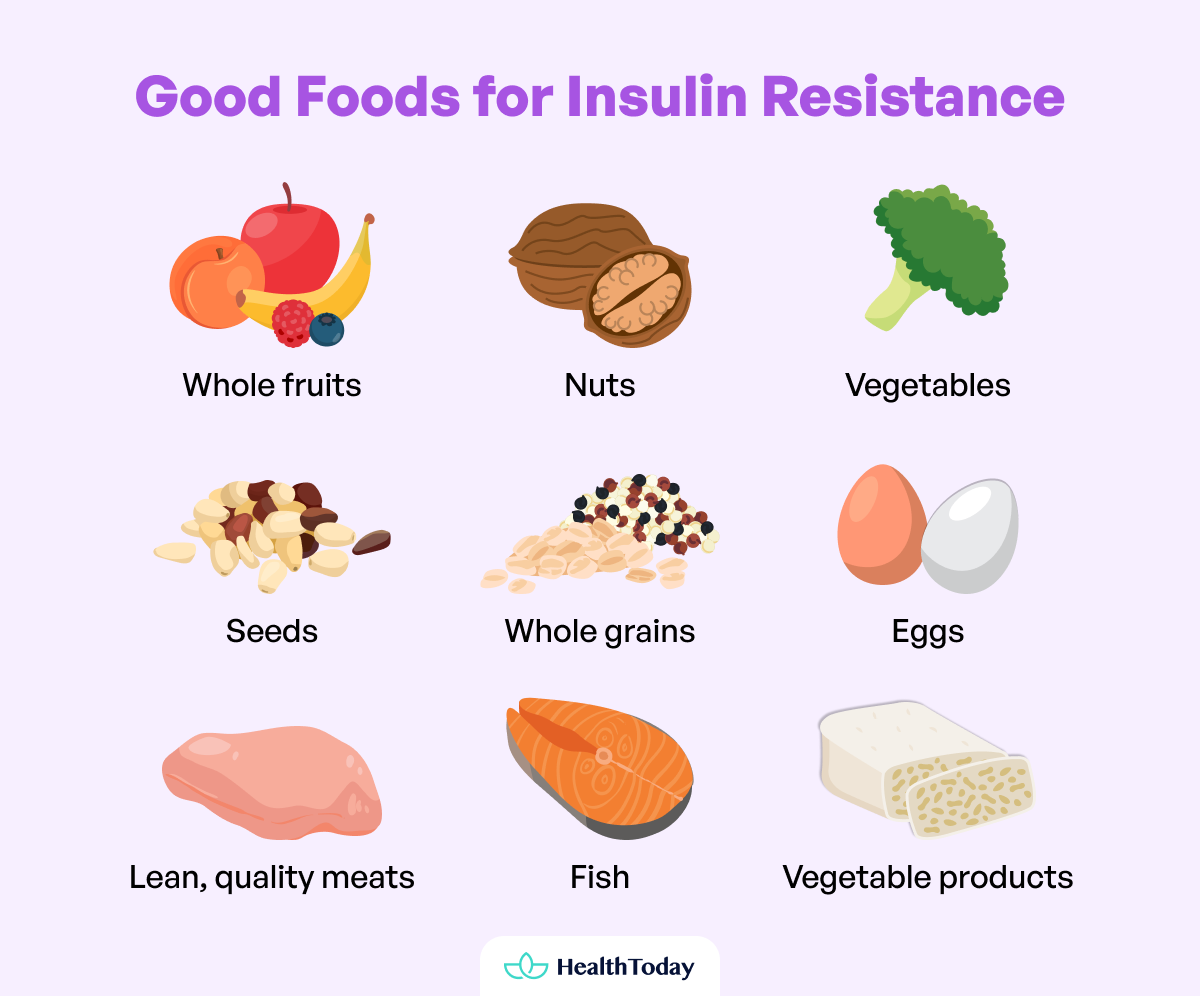

To prevent insulin resistance or reverse its symptoms and restore proper glucose levels, it is essential to prioritize certain food groups:
- Whole fruits are rich in fiber, vitamins, and antioxidants. Opt for fruits with fiber, such as apples, peaches, and bananas. Studies show that eating berries, especially cranberries, blueberries, raspberries, and strawberries, reduces high blood sugar and insulin levels after meals in overweight or obese adults with insulin resistance (13). Avoid fruit juices, which contain a lot of sugar and cause a blood glucose peak.
- Nuts such as walnuts should receive special mention since their calories come from fats instead of sugars, and their consumption is highly recommended for their health effects (14).
- Vegetables, like fruits, provide vitamins, minerals, and fiber but with a much lower glycemic effect.
- Seeds are an excellent source of fiber and omega-3 fatty acids.
- Whole grains such as brown rice, millet, quinoa, and oats contain fiber and important nutrients that can help regulate blood sugar levels, avoiding glycemic peaks by slowing the absorption of food (15).
- Eggs are an excellent source of high-quality proteins and other essential nutrients without providing carbohydrates.
- Lean, quality meats are rich in protein and important nutrients but choose lean options to avoid excess saturated fats.
- Fish is an excellent source of lean protein and omega-3 fatty acids, which can help improve insulin sensitivity.
- Vegetable products (tofu, textured soybeans, tempeh) are alternatives rich in vegetable protein and can be a healthy option for diversifying the diet and reducing animal protein consumption.
These are some foods to include in your diet for better metabolic control. Make sure that your diet is always varied with fresh foods, and avoid adding salt or sugar to your meals.
High fiber foods
Foods high in fiber are essential for anyone who wants a healthy and quality diet. For people with insulin resistance, it is recommended to consume these foods as they have multiple benefits such as (16, 17, 18):
- Digestive health: Fiber prevents constipation and regulates intestinal transit by increasing stool volume.
- Better blood glucose management: Fiber slows down the absorption of sugar from food, avoiding glucose peaks and maintaining blood sugar levels.
- Weight loss: Fiber enhances fullness, which helps reduce food intake. Consuming high fiber foods, accompanied by physical exercise, promotes weight loss.
- Cardiovascular health: Consuming soluble fiber reduces LDL cholesterol in the blood, which reduces the risk of cardiovascular diseases such as atherosclerosis and acute myocardial infarction.
Some foods rich in fiber are (19):
- White beans
- Dried beans
- Chickpeas, lentils
- Almonds
- Pistachios
- Corn
- Whole wheat bread
- Bananas
We recommend integrating these fiber-rich foods into your diet to avoid constipation, decrease blood sugar spikes, and enhance heart health.





Meals for insulin resistance: A 7-day plan
This plan can help you learn how to organize your meals, prioritize certain foods, and avoid others, such as sodas or fried foods.
Day 1:
- Breakfast: Coffee or tea with an organic/alternative choice of milk, served with a slice of whole wheat bread accompanied by chopped tomatoes, avocado, and fresh cheese.
- Lunch: Grilled fish filet, served with a side salad including broccoli, cauliflower, carrots, spinach, and mushrooms, and 1/4 cup of cooked white rice. Go to recipe.
- Dinner: Baked chicken filet with mushrooms and pumpkin. Plus, a pear for dessert. Go to recipe.
Day 2:
- Breakfast: Scrambled eggs, a slice of whole wheat bread, natural yogurt, and dried fruit.
- Lunch: Carrot salad with egg, one can of tuna, one fresh fruit. Go to recipe.
- Dinner: Stir-fried tofu with broccoli, peppers, and peas, served over brown rice. Go to recipe.
Day 3:
- Breakfast: Skim milk, yogurt with one small fruit.
- Lunch: Lentil soup with mixed green salad and a slice of whole wheat bread. Go to recipe.
- Dinner: Chicken salpicón with tomato, jalapeño pepper and avocado. Plus, one fresh fruit. Go to recipe.
Day 4:
- Breakfast: Whole wheat toast with smashed avocado and poached eggs, topped with a sprinkle of black pepper and sea salt.
- Lunch: Quinoa salad with black beans, corn, chopped peppers, cherry tomatoes and cilantro lime dressing. Go to recipe.
- Dinner: Baked chicken breast with roasted sweet potatoes and steamed broccoli. Go to recipe
Day 5:
- Breakfast: Blend skim milk with one banana and one apple.
- Lunch: Chicken and spinach skillet pasta with lemon and parmesan. Plus, one fruit. Go to recipe.
- Dinner: Meatballs with marinara sauce served over zucchini noodles. Go to recipe.
Day 6:
- Breakfast: Whole wheat pancakes with Greek yogurt and fresh berries.
- Lunch: Quinoa stuffed peppers with black beans, corn, chopped tomatoes and avocado. Go to recipe.
- Dinner: Cream of turkey with rice soup. Go to recipe.
Day 7:
- Breakfast: Vegetable omelet with mushrooms, onions, peppers and spinach.
- Lunch: Salmon salad with mixed lettuce, cucumber, avocado, red onion, hard-boiled eggs, and lemon dressing. Go to recipe.
- Dinner: Baked cod with steamed asparagus and a side of farro. Go to recipe.
This is an informative guide on how to choose and mix foods. Remember to balance nutrients with lean proteins, healthy fats, and complex carbohydrates. Incorporating two liters of water daily and moderate physical exercise will promote a healthy way to regulate insulin sensitivity.
Download Now for Easy Access!
Click the link below to download your 7-Day Meal Plan for Insulin Resistance and start your journey toward better health today!
[Download Your 7-Day Meal Plan PDF]
How to avoid insulin resistance
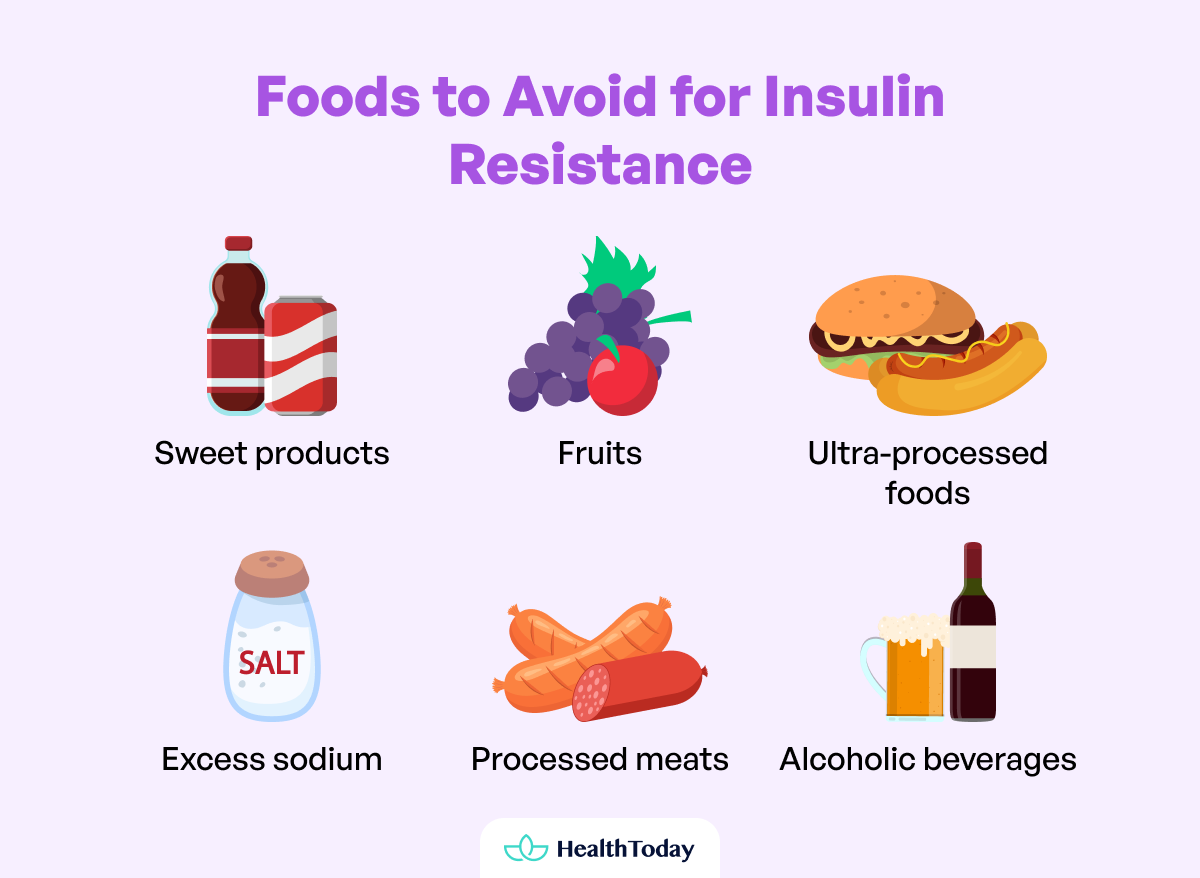

Avoid these foods that can raise blood glucose levels quickly and lead to other health problems:
- Sweet products: Eliminate desserts, chocolates, sugars, fruit juices, flavored waters, and soft drinks. These foods are rich in simple carbohydrates and can quickly raise blood glucose levels.
- Fruits: Consuming fruits can raise blood sugar levels. Therefore, eat them with other foods that contain fat, such as nuts or almonds. Alternatively, choose fruits that you can eat with their peel because it contains the fiber.
- Ultra-processed foods: Ultra-processed foods increase the risk of diabetes, so minimize their consumption (20).
- Excess sodium: The WHO recommends the maximum of 2000 mg of sodium per day, which equals 5 grams of salt per day (less than a teaspoon) (21). Insulin resistance combined with high salt intake can cause high blood pressure.
- Processed meats: Avoid consuming sausages, such as ham and chorizo, due to their high saturated fats and sodium content.
- Alcoholic beverages: Avoid consuming alcoholic beverages, including mixed drinks and beer, as they contain a high percentage of simple carbohydrates that can cause an increase in blood glucose levels.
In addition, the following healthy habits are recommended to combat insulin resistance:
- Adequate hydration: Consume two liters of water daily, distributed in small amounts throughout the day.
- Chewing your food: Take time to chew your food properly and enjoy each meal.
- Sleep management: Get 6 to 8 hours of sleep to promote metabolic health and appetite control.
- Regular exercise: Get at least 30 minutes of cardiovascular exercise daily, such as walking, running, swimming, or cycling, to improve insulin sensitivity and enhance cardiovascular health.
These are some principles for a healthy diet. If you have any doubts, consult a nutritionist for a better follow-up.





What can I take for insulin resistance?
To address insulin resistance, follow a comprehensive treatment plan that includes dietary changes and regular exercise, Sometimes prescription medications such as metformin are needed. Consult with a healthcare professional for specific recommendations based on your individual dietary needs.
Which oil is bad for insulin resistance?
Refined vegetable oils have been associated with an increased risk of insulin resistance and diabetes (22). Instead, opt for healthy oils such as extra virgin olive oil.
What happens after one month of intermittent fasting?
The effects of intermittent fasting may vary from person to person. However, after one month, it is possible to experience benefits such as weight loss, improved blood sugar control, and improved insulin sensitivity, as well as improved cellular health and immunity.
Does yogurt spike insulin?
Plain yogurt generally has a low glycemic index and does not tend to raise insulin levels sharply. However, flavored yogurts may contain added sugars that can affect glucose and insulin levels.
Is keto good for insulin resistance PCOS?
Some research suggests that the ketogenic diet may be beneficial for insulin resistance associated with polycystic ovary syndrome (PCOS) (23). However, more research is needed to fully understand the long-term effects of the keto diet on PCOS.
Summary
According to different studies, insulin resistance is a common problem that affects a large portion of the population, with up to 40 percent of young adults in the United States experiencing it. This problem can lead to the development of type 2 diabetes and other serious metabolic complications.
Diet is key in the prevention and management of insulin resistance. Dietary patterns that include processed foods, added sugars, and unhealthy fats can contribute to the development of this condition. On the other hand, a diet rich in whole foods, fruits, vegetables, lean proteins, and healthy fats can help improve insulin sensitivity and stabilize blood sugar levels.
The low-carbohydrate and ketogenic diets are specific approaches that can improve insulin sensitivity by reducing blood glucose spikes and promoting the burning of fat as a source of energy. However, it is important to work with a healthcare professional to determine the best dietary strategy for each individual.
In addition to diet, other healthy habits, such as regular exercise, adequate sleep, and hydration, are critical to managing insulin resistance and preventing its complications. Addressing insulin resistance is important to promote better metabolic health and reduce the risk of chronic diseases.








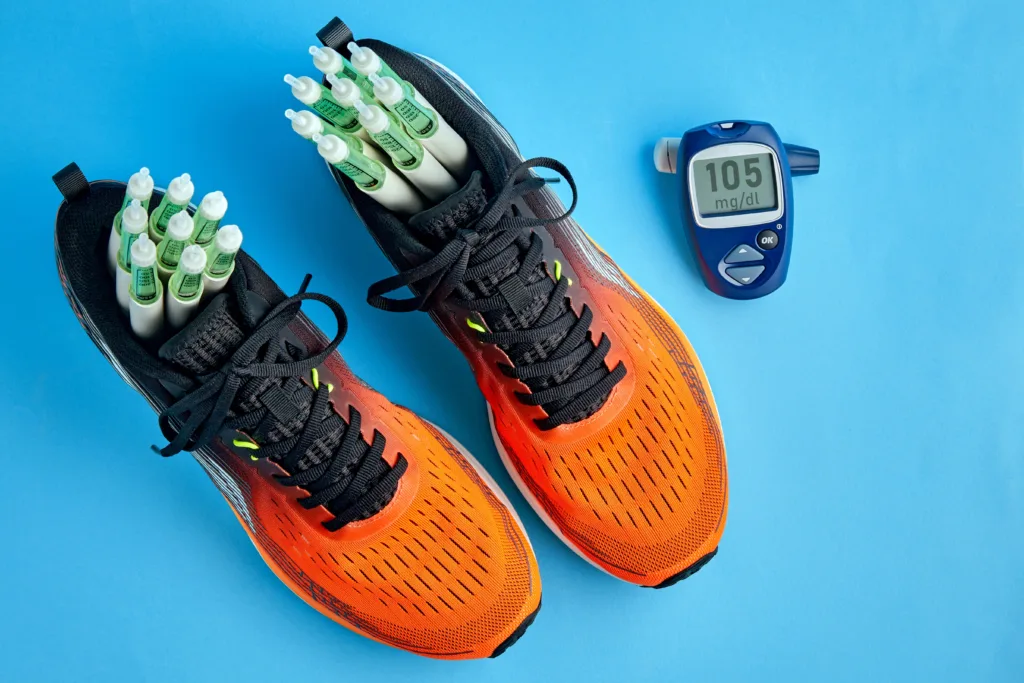

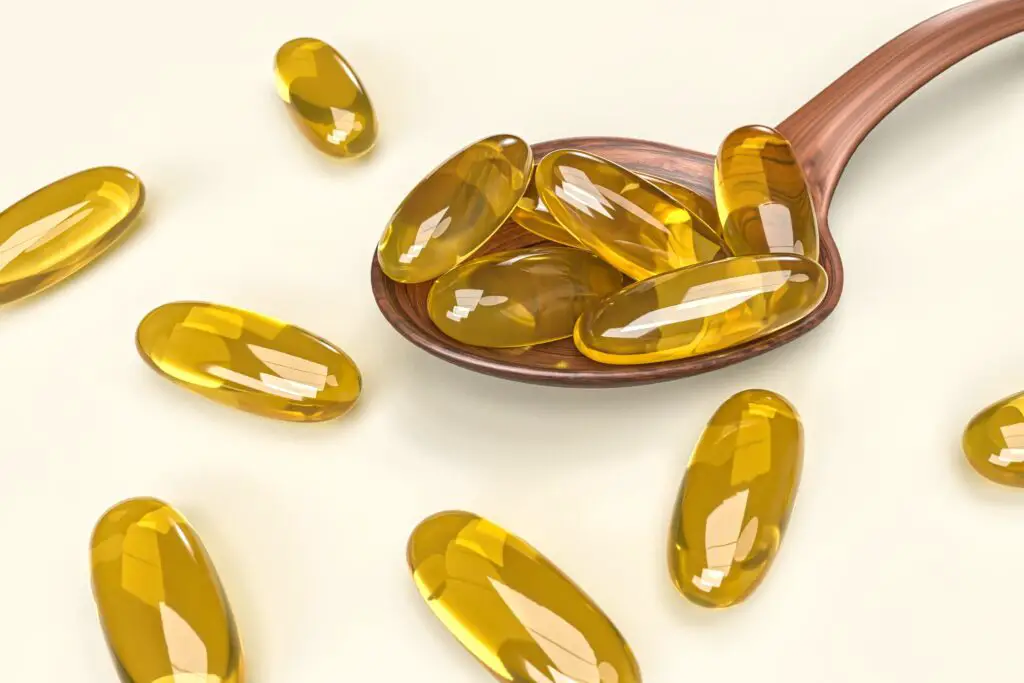

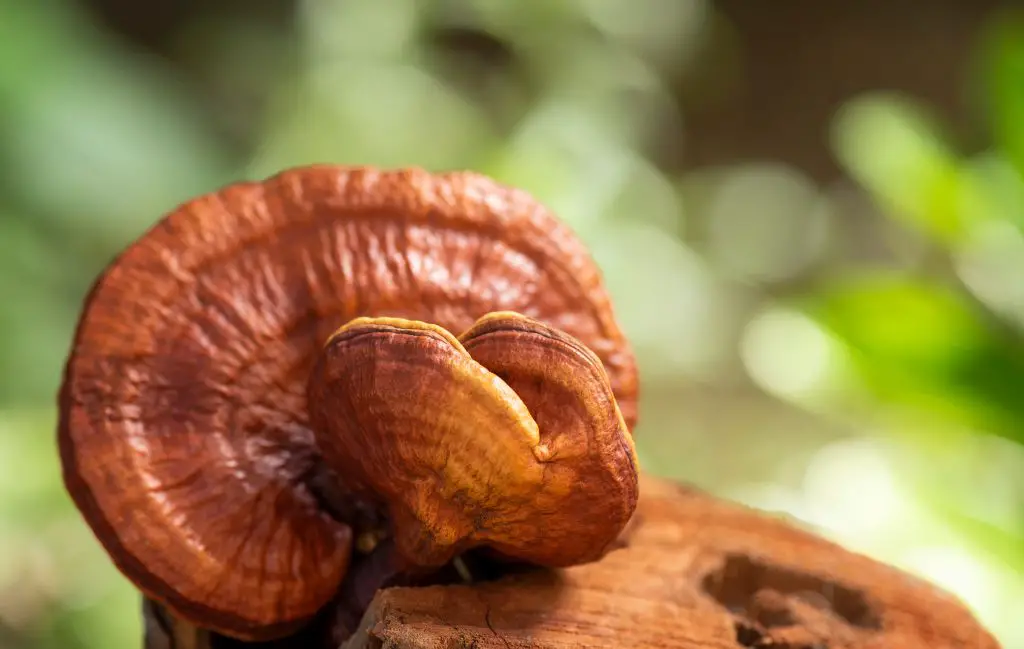




Comments
0